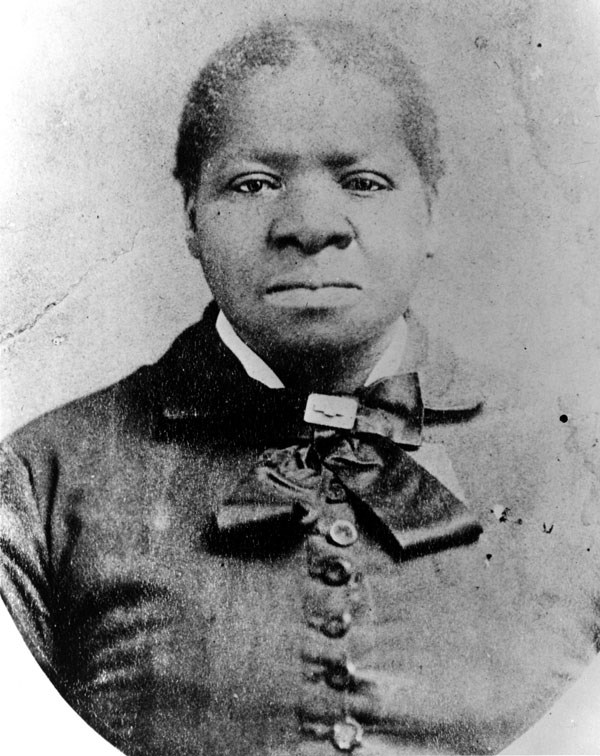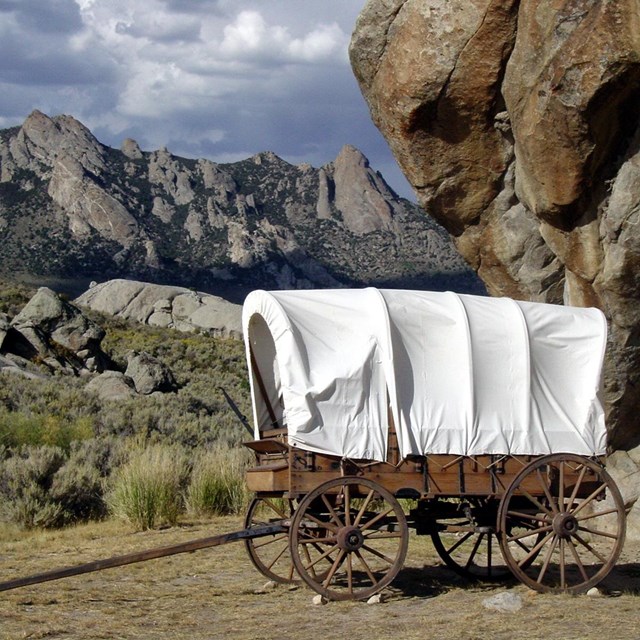Part of a series of articles titled People of the California Trail.
Article
Bridget “Biddy” Mason, the California Trail

Photo/Public Domain
Bridget “Biddy” Mason – California Trail
By Angela Reiniche[1]
“If you hold your hand closed …nothing good can come in. The open hand is blessed, for it gives in abundance, even as it receives.”
– Biddy Mason
On 22 January 1856, Bridget “Biddy” Mason and twelve members of her extended family left the Los Angeles courtroom of Judge Benjamin Hayes as free people. She had lived as an enslaved person in California, a supposedly “free” state, for nearly five years. Her story is testament to the many obstacles that Black Americans faced in securing basic civil rights—even in states that technically prohibited slavery.
Born enslaved in 1818 in either Georgia or Mississippi, Mason was purchased by Robert Marion Smith, a Mormon convert and owner of a Mississippi plantation.[2] When Brigham Young called for the members of the Church of the Latter-day Saints to settle in the North American West, Smith followed. Mason and her children became part of a cadre of enslaved men, women, and children who had no choice but to follow their enslavers to Utah. Mason, thirty years old at the time they left in 1848, walked 1,700 miles at the back of a 300-wagon caravan before stopping in the Holladay area of the Great Salt Lake Valley. Along the way, Mason performed many duties that she had performed in Mississippi—now made all the more difficult by the conditions of overland travel. The journey itself included some new responsibilities as well, such as setting up and breaking camp and herding livestock. Using “buffalo chips” as fuel to prepare meals certainly transformed Mason’s cooking tasks; she likely employed her midwifery skills, as well. Mason also cared for her three daughters, though her ten-year-old daughter likely helped with Mason’s infant and four-year-old daughter.[3]
After two years in Utah, Young called the “Mississippi Saints” to establish a new community in San Bernardino, California. Smith left the Holladay settlement in a caravan of 150 wagons, taking Mason with him. Like many slaveholding emigrants, Smith was aware of California’s prohibition against slavery; Mason was also aware, owing to conversations with free Blacks that she met during the journey and in California. Eventually, Smith—afraid of losing Mason and the others he enslaved—attempted to move to Texas in December 1855.
Mason’s free Black friends Robert and Minnie Owens, however, had other plans. Because one of their sons was involved with Mason’s eldest daughter, Hannah (who was seventeen at the time), the Owens family wanted to keep the Mason family in California; Robert Owens thus told the Los Angeles County Sheriff that Mason and others were being illegally kept in bondage. A posse including Owens, his sons, and hands from the Owens’ ranch detained Smith’s wagon train at Cajon Pass and prevented him from leaving California. Within a month, Biddy Mason petitioned the court for her freedom and that of her extended family. Throughout the trial, Smith denied any wrongdoing. Yet even though she could not testify publicly against Smith, Mason prevailed. Judge Benjamin Hayes deliberated for three days before granting freedom to Mason and her family, citing the prohibition of slavery that had been part of California’s first constitution in 1850.[4]
Mason would become a pillar of Los Angeles’ African American community. She was a midwife, nurse, and organizer of the First African Methodist Episcopal Church, the city’s oldest African American church. Mason made sure that her children were educated, and she used her wealth in ways that benefited the entire community.[5] After her successful court battle, Mason and her daughters stayed with the Owens family. Mason herself worked as a nurse for John S. Griffin, a Los Angeles physician, earning $2.50 a day for her service.[6] Ten years later, in 1866, Mason purchased a home in present-day downtown Los Angeles; it quickly became a favorite gathering place for her family and friends.[7] Moving away from Church of Jesus Christ of Latter-day Saints, she and Charles Owens—her daughter Ellen’s husband—founded the Los Angeles branch of the First African Methodist Episcopal (AME) Church in 1872. Their first meetings and official organization took place in her home. Though she financially supported the AME Church—she paid its property taxes and the minister’s salary—Mason and her family attended the Fourth Street Methodist Episcopal Church, a predominantly white congregation across the street from her home.[8]
Mason’s great-grand daughter, Gladys Owens Smith, recalled something Mason often told her: “If you hold your hand closed … nothing good can come in. The open hand is blessed, for it gives in abundance, even as it receives.” After a life of giving in abundance, Mason died in Los Angeles on 15 January 1891. She was buried in Evergreen Cemetery in the Boyle Heights district.[9]
[1] Part of a 2016–2018 collaborative project of the National Trails- National Park Service and the University of New Mexico’s Department of History, “Student Experience in National Trails Historic Research: Vignettes Project” [Colorado Plateau Cooperative Ecosystem Studies Unit (CPCESU), Task Agreement P16AC00957]. This project was formulated to provide trail partners and the general public with useful biographies of less-studied trail figures—particularly African Americans, Hispanics, American Indians, women, and children.
[2] Smith’s exact birthplace is unknown. The 1860 Census lists Mississippi, but 1870 and 1880 indicate Georgia; so did her obituary in the Los Angeles Times. See Delores Hayden, The Power of Place: Urban Landscapes as Public History (Cambridge: MIT Press, 1995), 274.
[3] Tricia Martineau Wagner, “Bridget ‘Biddy’ Mason (1818–1891),” blackpast.org, accessed May 11, 2107, http://www.blackpast.org/african-americans-and-church-jesus-christ-latter-day-saints; and Jessie Carney Smith, ed. Epic Lives of One Hundred Black Women Who Made a Difference (Detroit, Mich.: Visible Ink Press, 1993), 58.
[4] Wagner, “Biddy Mason.”
[5] Wagner, “Biddy Mason”; Shirley Ann Wilson Moore, Sweet Freedom’s Plains: African Americans on the Overland Trails, 1841–1869 (Norman: University of Oklahoma Press, 2016), 198.
[6] Moore, Sweet Freedom’s Plains, 149. 1860 U.S. Census, Los Angeles population schedule. NARA microfilm publication M653, 1,438 rolls. Washington, D.C.: National Archives and Records Administration, n.d. Ancestry.com. 1860 United States Federal Census [database on-line]. Provo, UT, USA: Ancestry.com Operations, Inc., 2009. On October 30, 1862, Biddy Mason paid a $10 federal tax to hold a license as a “physician.” Internal Revenue Assessment Lists for California, 1862-1866; (National Archives Microfilm Publication M756, 33 rolls); Records of the Internal Revenue Service, Record Group 58; The National Archives at Washington, D.C. Ancestry.com. U.S. IRS Tax Assessment Lists, 1862-1918 [database on-line]. Provo, UT, USA: Ancestry.com Operations Inc, 2008.
[7] Moore, Sweet Freedom’s Plains, 199; 1870 United States Federal Census [database on-line]. Provo, UT, USA: Ancestry.com Operations, Inc., 2009. 1870 U.S. census, population schedules. NARA microfilm publication M593, 1,761 rolls. Washington, D.C.: National Archives and Records Administration, n.d.
[8] Moore, Sweet Freedom’s Plains, 199.
[9] Moore, Sweet Freedom’s Plains, 113; and Dolores Hayden, “Biddy Mason’s Los Angeles, 1856-1891,” California History 62, no. 3 (1989): 89, 94n7.
Last updated: March 7, 2023


